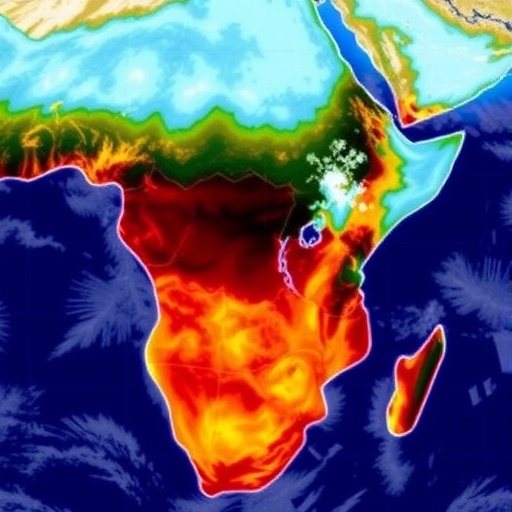The El Niño–Southern Oscillation (ENSO) is one of the most significant drivers of climate variability across the globe, particularly impacting weather patterns in Africa. As a phenomenon that oscillates between the warm El Niño and the cold La Niña phases, ENSO’s influence extends deeply into the climate systems of various regions, causing marked changes in precipitation and temperature. The complexity of ENSO’s interactions with atmospheric and oceanic systems necessitates a critical examination of how these shifts unfold uniquely across different seasons and geographical areas.
The seasonal variability of ENSO’s effects is profoundly significant, especially when considering the diverse climatic zones across Africa. For instance, during the July to September period, ENSO induces noteworthy rainfall anomalies in the Sahel region. This is primarily attributed to shifts in tropospheric temperatures that are tied to the dynamics of ENSO events. The relationship between sea surface temperatures in the Pacific Ocean and atmospheric pressure changes leads to alterations in the regional weather patterns, warranting further examination of these intricate dynamics.
Months later, from October to December, a critical weather transition occurs, characterized by a significant dipole effect across eastern and southern Africa during the short rainy season. The impact during these months is intricately linked to interactions with other climatic phenomena such as the Indian Ocean Dipole (IOD). The IOD’s variations enhance or suppress rainfall across these regions, showcasing how interconnected global climatic systems impact local weather.
Continuing the analysis of ENSO’s influence into the December to February phase, research indicates further synchronization with the Indian Ocean Basin mode; these interactions often enhance or detract from the precipitation reliability in southern and eastern Africa. This complex and multifaceted mechanism illustrates the dual role ENSO plays during these months, contributing either to drought conditions or excessive rainfall depending on the prevailing phase of the oscillation and ongoing Indian Ocean dynamics.
As we transition into the March to May long rainy season in Africa, ENSO’s influence remains prominently visible. This period is marked by noticeable anomalies over southern Africa, often with inverse weather patterns in areas like East Africa. This is attributed to the ongoing continuation of the Indian Ocean Basin mode during this time. Thus, analyzing the temporal shifts of ENSO’s impact provides crucial insights into predicting agricultural viability and addressing food security across regions heavily reliant on rain-fed farming systems.
The patterns of anomalies linked to ENSO tend to be most pronounced during specific events, particularly those classified as East Pacific El Niño and Central Pacific La Niña. Understanding why certain ENSO events produce more significant climatic outcomes is vital for improving predictive models. The varying impacts during these events underscore the importance of pinpointing which mechanisms are at play, especially during decades when these inter-basin interactions exhibit heightened strength.
Scientific modeling of ENSO-related climate impacts continues to evolve, yet these models inherently face challenges in accurately simulating the complex interactions governing regional climates in Africa. Despite these challenges, advanced climate models suggest that the impacts associated with ENSO are likely to intensify in the future. This predictive modeling raises significant concerns as they imply an increased frequency of extreme weather events, both dry and wet.
Further research into the regional circulations and their responses to ENSO is vital for formulating effective adaptation strategies in African countries, most of which depend on agriculture as a primary livelihood source. The need for robust, realistic simulations of these climatic variables grows ever more pressing as the effects of climate change unfold, potentially exacerbating existing vulnerabilities within the agricultural sector.
A collaborative approach among climate scientists, policymakers, and local communities becomes crucial in developing frameworks that facilitate better understanding and management of ENSO-related climate variability. The relationship between ENSO and African climates emphasizes the need for accessible and actionable climate data, allowing stakeholders to make informed decisions that mitigate the adverse impacts of these fluctuations.
In conclusion, addressing the intricacies of ENSO’s impact on Africa requires continuous research and innovative scientific approaches. Only through a thorough understanding of the seasonal dynamics, regional idiosyncrasies, and interconnections with global climatic systems can we develop resilient agricultural and societal frameworks that withstand the looming challenges posed by climate variability and change. As much of Africa remains vulnerable to rainfall anomalies linked with ENSO, prioritizing comprehensive research initiatives will be pivotal for sustainable development and food security in the coming decades.
Policymakers need to prioritize investment in climate modeling and stakeholder engagement to directly address the emerging realities shaped by ENSO. Collaborative efforts at both national and regional levels can create pathways for integrating climate science into planning and development strategies, ensuring that communities are equipped to adapt to impending climatic changes.
By fostering greater awareness of how climatic phenomena like ENSO influence local environments, we empower communities with the knowledge necessary to safeguard their futures. The dialogue around ENSO and its implications for climate patterns across Africa is far from complete; it is an evolving narrative that demands our collective attention and action.
Ultimately, enhancing our understanding of the climate impacts wrought by ENSO in Africa is a quest that leads to advancing not only scientific inquiry but also holistic strategies that ensure resilience for generations to come. The stakes are high, but so are the opportunities for innovation and adaptation in tackling the myriad challenges of climate variability that lie ahead.
Subject of Research: Climate impacts of the El Niño–Southern Oscillation in Africa.
Article Title: Climate impacts of the El Niño–Southern Oscillation in Africa.
Article References:
Cai, W., Reason, C., Mohino, E. et al. Climate impacts of the El Niño–Southern Oscillation in Africa. Nat Rev Earth Environ 6, 503–520 (2025). https://doi.org/10.1038/s43017-025-00705-7
Image Credits: AI Generated
DOI: 10.1038/s43017-025-00705-7
Keywords: ENSO, climate variability, rainfall anomalies, Africa, El Niño, La Niña, Indian Ocean Dipole, climate modeling, agriculture, food security.




